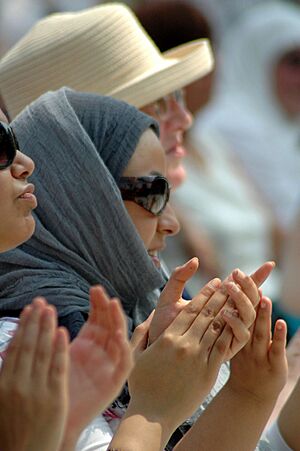Applause facts for kids
Applause is the sound an audience makes by clapping their hands. People clap to show they like something, to thank someone, or to welcome performers.
Imagine you are at a concert. When the musicians walk onto the stage, people often clap. This is a way of saying "hello" and showing excitement. After the music finishes, the audience claps again. This time, they are thanking the performers for their hard work and for the great show.
People applaud in many different situations. You might hear applause after a great speech, at a sporting event, or at the end of a play or an opera. The louder and longer the applause, the more the audience probably enjoyed the performance! If they really loved it, they might even shout "BRAVO!"
Sometimes, the excitement is so great that the applause becomes very loud and enthusiastic. This is called an ovation. If the audience is extremely impressed, they might even stand up while clapping. This special kind of applause is known as a standing ovation. It's a big compliment to the performers!
Why Do People Applaud?
Applause is a way for people to share their feelings as a group. It's a non-verbal way to communicate appreciation, approval, or excitement.
- Showing Thanks: Performers, speakers, or athletes often work hard. Applause is a way to thank them for their effort.
- Showing Approval: If someone does something well, applause shows that the audience approves and enjoyed it.
- Encouragement: Sometimes, applause can also be a way to encourage someone, like at a sporting event.
- Building Community: When everyone claps together, it creates a shared moment and a feeling of connection among the audience.
History of Applause
People have been applauding for thousands of years! In ancient Rome, audiences would clap, snap their fingers, or even wave the ends of their togas (a type of clothing) to show approval. Over time, clapping hands became the most common way to applaud in many cultures.
Different cultures might have slightly different ways of showing appreciation. While clapping is very common, some cultures might use other sounds or gestures.
Related pages
See also
 In Spanish: Aplauso para niños
In Spanish: Aplauso para niños


